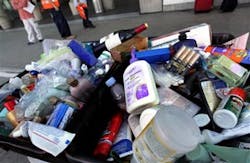Lattes, IPods Among Air Security Fears
Shampoo, iPods and Starbucks lattes have suddenly become security threats. Terrorists could easily slip a few apparently innocuous items past airport security and assemble them into a lethal explosive once aloft, security experts said.
Some envision a group of two or three terrorists mixing up explosives in an airplane bathroom, perhaps even using commonplace materials such as hydrogen peroxide and detonating their bomb with the battery from a cellphone or some other small electronic device.
"In mid-flight you could go into the toilet, attach the mobile phone to the explosives and, as the plane makes a final approach over a densely populated urban area, you detonate it," said Irish security analyst Tom Clonan.
To puncture an aircraft's fuselage would require an explosive charge "half the size of a cigarette packet," he said.
Experts interviewed after Thursday's arrest of suspects in a massive airline bomb plot say there are many ways that seemingly innocuous substances could be smuggled aboard a plane and assembled into an explosive device in flight.
That means airport security screening, now focused on detecting weapons and large amounts of explosives, might have to ban such workday items as cell phones, hand sanitizer and contact lens solution. Flying could become an experience of extreme privation from the conveniences of modern life, preceded by even more onerous security screening.
"That theater we see, of people taking off shoes, is not going to stop a suicide bomber. The terrorists have already sniffed out the weak spots and are adopting new tactics," Clonan said.
Officials declined to discuss whatever technology the thwarted plot uncovered. But British authorities banned all carry-on luggage, suggesting that the explosives or their ingredients would have been difficult or impossible for airport security screening to detect.
In the United States, hand luggage was still being allowed, but liquids were banned except for baby formula, insulin and other medicines.
"We are taking the step of preventing liquids from getting into the cabin to give us time to make adjustments in our current screening tactics, based upon what we learn from this investigation," Homeland Security Secretary Michael Chertoff said Thursday morning.
Experts said the measures suggest that terrorists planned to sneak one or more bomb ingredients aboard as many as 10 aircraft, then mix and wire them to a battery detonator.
"Their intention was to smuggle on board some kind of liquid explosive disguised as an aftershave bottle or hair conditioner or shampoo or whatever," said M.J. Gohel, who is director of the Asia-Pacific Foundation, a London-based think tank.
A similar threat in January 1995 led officials in the Philippines to briefly ban aerosol sprays, bottled gels and liquid containers of more than about an ounce from departing planes because of a suspected terror plot during a visit by Pope John Paul II. As in the current situation an exception was made for baby formula, even though in powdered form it could easily disguise explosives.
The Philippines plot was masterminded by Ramzi Youssef, now serving a life sentence for the first World Trade Center attack. He planned to assemble bombs using a nitroglycerin-based liquid explosive disguised as contact lens solution. The bombers were to use digital watches as timed detonators and leave the devices on board after leaving the flights during layovers.
The plot was foiled with an explosion from the Manila apartment where Youssef was doing experiments.
"The need to address this liquid explosives problem is over 10 years old," U.S. Rep. Ed Markey, D-Mass., complained in a statement issued Thursday that called for improved airport security screening.
Nitroglycerin and similar explosives have become much harder to slip by aiport security today than they were a decade ago thanks to "sniffer" machines that can detect trace amounts of explosives residue on luggage and passengers.
Partly for that reason, terrorists have increasingly turned to peroxide-based explosives such as TATP, which was used in last year's London subway bombings. Production of the explosive has been perfected over the past several decades by Palestinian bomb-makers who produce it using bleach, drain cleaner and acetone paint thinner.
In 2001 shoe bomber Richard Reid was subdued by fellow passengers on a trans-Atlantic flight while trying to ignite a bomb in his shoes made out of plastic explosives with a TATP trigger. The 2005 London subway bombings also relied on TATP, a powder explosive.
More dangerous than nitroglycerin or TATP are various liquid explosives that could be transported in sealed containers, making them undetectable to sensors that pick up volatile gasses that are typically emitted by explosive substances.
For safety reasons, said John Pike, director of Washington-based think tank Globalsecurity.org, some commercial products are even designed to be transported as two relatively inert substances and then mixed together on site to produce an explosive.
___
Associated Press writer Shawn Pogatchnik in Dublin contributed to this report.
News stories provided by third parties are not edited by "Site Publication" staff. For suggestions and comments, please click the Contact link at the bottom of this page.

